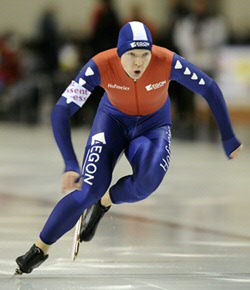Getting to the bottom of skater’s cramp
Former elite speed skater Beorn Nijenhuis is now a neuroscientist. He is currently conducting PhD research at Campus Fryslân into the mysterious phenomenon of skater’s cramp – the nightmare of every top-class speed skater.
It is a collective trauma for all Dutch sports fans over the age of 40: the skater’s cramp that afflicted the young speed skating talent Gerard Kemkers. In 1988, he won a bronze medal at the Olympic Games, but a year later, his stroke became asymmetric and inefficient. And that’s the way it stayed. Two years later, the speed skater said goodbye to his promising career at the young tender age of 23.
The dreaded skater’s cramp has been notorious ever since: several elite speed skaters have been affected, usually very suddenly. The cause has never been found. ‘It has been the subject of many articles and discussions,’ says Beorn Nijenhuis, former Olympic speed skater, ex-pupil of Gerard Kemkers, and now a neuroscientist and PhD student at the UG. ‘I am trying to discover whether skater’s cramp is a neurological symptom, similar to movement disorders that we sometimes see in other highly specialized skills.’

Nijenhuis explains that certain complex motor activities require thousands of hours of practise to perfect. Take playing the violin or piano, serving a tennis ball, archery, or even writing. ‘Professionals performing any of these tasks occasionally make sudden, uncontrolled movements’, Nijenhuis continues. ‘It resembles cramp, and it occurs repeatedly at a specific point during the movement.’ Strangely enough, the disorder suddenly starts to manifest itself usually after someone has been performing at top-class level for around 15 years. It is called ‘writer’s cramp’ when it happens to writers, ‘the yips’ with tennis players and golfers, and ‘target panic’ with archers. ‘The effect is devastating’, Nijenhuis is keen to stress. ‘It usually means an end to someone’s career.’
Human movement scientists refer to it as ‘task-specific dystonia’, and it affects some one to two percent of professional musicians. There are no clear figures for sportsmen and women yet, as the disorder varies greatly per activity and very little research has been carried out. Nijenhuis: ‘I am trying to discover whether skater’s cramp really is an example of task-specific dystonia. We’re not quite sure at the moment.’
There are no well-defined criteria for diagnosing skater’s cramp. The cause is a mystery and treatment options are currently unavailable. Nijenhuis, who has been working as a PhD student with Professor Marina Koning-Tijssen from the University Medical Center Groningen (UMCG) for the past two years, hopes to get to the bottom of this. At the same time, he is also looking for better methods of studying movement disorders like this.
Nijenhuis is following the development of 15 elite speed skaters with skater's cramp. He is comparing them with skaters who are not afflicted. Ideally, he would like to measure the brain activity of both groups while they are skating. ‘Unfortunately, this isn't an option’, he says. ‘You can only do that in a big MRI scanner. What we can do is to measure muscle activity very precisely while they are skating, and analyse their movements using video recordings.’
The data show that skater’s cramp occurs very consistently during the skater’s stroke, and according to a fixed pattern. ‘This points towards an abnormality in the central nervous system’, says Nijenhuis. ‘And that it is, in fact, a case of task-specific dystonia.’ He is now trying to explain exactly what goes on inside the leg when this happens. He has his suspicions and even has a few ideas about how to treat it – but he’s not at liberty to discuss that yet: he hopes to publish an article in an academic journal about it very soon.
This article has been taken from our alumni magazine Broerstraat 5. Text: Nynke Beintema
